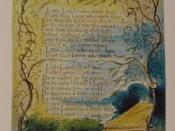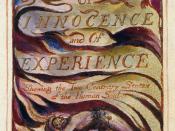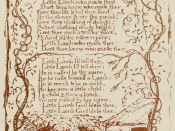Many poems written by the same author often have similar themes. The authors usually believe in something very strongly and their poems usually reflect such a nature. Sometimes poets reflect aspects of their personal life in their poems. In the poems 'The Lamb' and 'The Tiger', by William Blake, the poet discusses similar themes in both.
In the poem 'The Lamb', I interpret that William Blake discusses many points questioning creation and religion. He describes the lamb as being an object of innocence and fragility when he says 'Gave thee clothing of delight, Softest clothing, woolly, bright; Gave thee such a tender voice' (line 5). 'Blake develops an elaborate personal mythology that underlies virtually all symbolism and ideas in his work.' (Shilstone, p.223) Blake discusses that the creator of the lamb is also calls Himself a Lamb. With this he brings religious significance into the poem.
It the New Testament, Jesus of Nazareth is referred as God's Lamb.
There are a few themes developed in 'The Lamb.' Blake describes the lamb as symbol of childhood innocence. He also questions about how the lamb was brought into existence, which mentions another theme of divine intervention and how all creatures were created. The poem is nothing but one wondering question to another (Harmon, p. 361).
'The Tiger' by William Blake describes the tiger as being an symbol of evil. This is displayed when Blake says 'What an anvil? what dread grasp, Dare its deadly terrors clasp?' By repeating variations of the word 'dread' in the poem, he emphasizes the evil of tiger and the evil this tiger possesses. The mighty beast is whole world of experience outside ourselves, a world of igneous creation and destruction, faced with a terrifying beauty (Harmon, p.360). This poem also...


